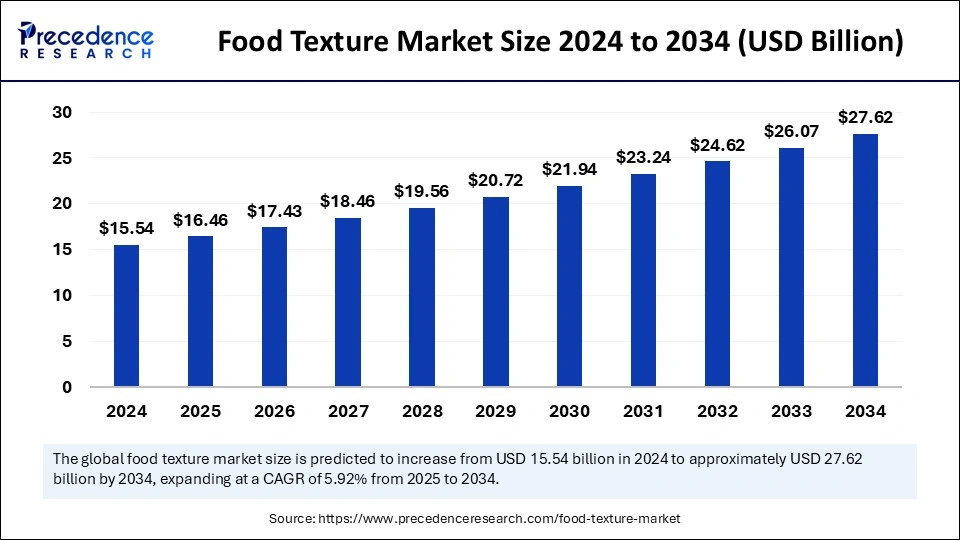Food Texture Market is projected to exceed USD 27.62 billion by 2034.
The global food texture market was valued at USD 15.54 billion in 2024 and is projected to reach approximately USD 27.62 billion by 2034, expanding at a CAGR of 5.92% from 2025 to 2034.
Food Texture Market Key Insights
- North America led the global food texture market with the largest share in 2024.
- Asia Pacific is estimated to expand the fastest CAGR between 2025 and 2034.
- By type, the cellulose derivatives segment held the biggest market share in 2024.
- By type, the starch segment is anticipated to grow at a remarkable CAGR between 2025 and 2034.
- By application, the dairy products and ice cream segment captured the highest market share in 2024.
- By application, the bakery segment is expected to expand at a notable CAGR over the projected period.
- By product, the natural segment contributed the largest market share in 2024.
- By product, the synthetic segment is expected to expand at a notable CAGR over the projected period.
The food texture market is witnessing steady growth due to increasing consumer demand for enhanced sensory experiences in food products. Texture plays a crucial role in food perception, influencing mouthfeel, consistency, and overall product appeal. Food texture ingredients, such as hydrocolloids, emulsifiers, and stabilizers, are widely used in processed foods, bakery products, dairy, confectionery, and beverages to improve quality, shelf life, and consumer satisfaction. The rising preference for premium, natural, and clean-label products is further driving innovation in the market. With growing advancements in food processing technologies and the demand for plant-based and functional foods, the food texture industry is expected to expand significantly in the coming years.
Sample Link: https://www.precedenceresearch.com/sample/5703
Market Drivers
Several key factors are fueling the growth of the food texture market
- Increasing Demand for Processed & Convenience Foods – The growing consumption of ready-to-eat and packaged foods has led to a higher need for texture-enhancing ingredients to maintain consistency and quality.
- Rising Consumer Preference for Sensory Appeal – Consumers are increasingly drawn to food products that offer a unique texture, whether it be creamy, crispy, chewy, or smooth, driving manufacturers to enhance their formulations.
- Expansion of the Plant-Based & Dairy-Free Industry – The rise of plant-based diets has increased the demand for texture-modifying ingredients in dairy alternatives, meat substitutes, and vegan confectionery.
- Technological Advancements in Food Processing – Innovations in food hydrocolloids, starch modifications, and emulsifier technologies are enhancing product stability and improving food textures.
- Growing Awareness of Clean-Label & Natural Ingredients – Consumers are seeking natural and clean-label texture enhancers, pushing manufacturers to replace synthetic additives with plant-based alternatives.
Opportunities
The food texture market presents several promising growth opportunities
- Innovation in Functional Food & Nutraceuticals – The rising trend of functional foods, including high-protein, fiber-rich, and fortified products, is creating demand for texture-enhancing ingredients that improve palatability.
- Emerging Markets & Expanding Processed Food Industry – Rapid urbanization and changing dietary habits in Asia-Pacific, Latin America, and the Middle East are boosting demand for texturizers in packaged and processed foods.
- Advancements in Food Ingredient Technologies – Continuous research in starch derivatives, hydrocolloids, and protein-based texturizers is enabling the development of novel texture solutions with improved health benefits.
- Sustainable & Eco-Friendly Ingredient Alternatives – The rising focus on sustainability is driving the development of plant-based and biodegradable texture-modifying agents as replacements for synthetic additives.
- Personalized Food Experiences – Increasing interest in customized food textures tailored to specific consumer preferences, including aged care and sports nutrition, is opening new market segments.
Challenges
Despite its growth potential, the food texture market faces several challenges
- Regulatory & Labeling Restrictions – Strict regulations on food additives and clean-label requirements in different regions can limit the use of certain texture-enhancing ingredients.
- Cost Constraints in Natural & Organic Ingredients – The high cost of plant-based and natural texturizers compared to synthetic alternatives can be a barrier for small food manufacturers.
- Consumer Perception of Food Additives – Some consumers remain skeptical about the inclusion of texturizing agents in their food, perceiving them as artificial or unnecessary.
- Supply Chain Disruptions & Raw Material Availability – The sourcing of raw materials for natural texturizers, such as hydrocolloids and starches, can be affected by climatic conditions and supply chain issues.
- Complex Formulation Challenges – Achieving the desired texture while maintaining product stability, taste, and nutritional value requires extensive research and development, adding to production costs.
Regional Insights
- North America – The region leads the food texture market due to high consumer demand for premium and innovative food products. The U.S. and Canada have a strong presence of food processing industries incorporating advanced texturizers.
- Europe – Countries like Germany, France, and the UK are at the forefront of clean-label and natural texture-enhancing ingredients. The region has stringent regulations, pushing manufacturers toward organic and plant-based solutions.
- Asia-Pacific – The fastest-growing market, driven by rising disposable incomes, urbanization, and an increasing appetite for processed foods in China, India, and Japan. The expansion of the dairy and bakery industries further fuels demand.
- Latin America & Middle East & Africa – These regions are witnessing growth due to increasing consumer preference for convenience foods, but regulatory challenges and limited awareness of texture-enhancing ingredients pose hurdles.
Read Also: Baking Ingredients Market
Market Companies
Segments Covered in the Report
By Type
- Gums
- Pectins
- Gelatins
- Starch
- Inulin
- Dextrins
- Others
- Cellulose Derivatives
By Application
- Dairy Products and Ice Creams
- Confectionery
- Jams
- Layers
- Fillings
- Bakery
- Ready Meals
- Sauces
- Beverage
- Others
- Meat Products
By Product
- Natural
- Synthetic
By Geography
- North America
- Europe
- Asia-Pacific
- Latin America
- Middle East and Africa

